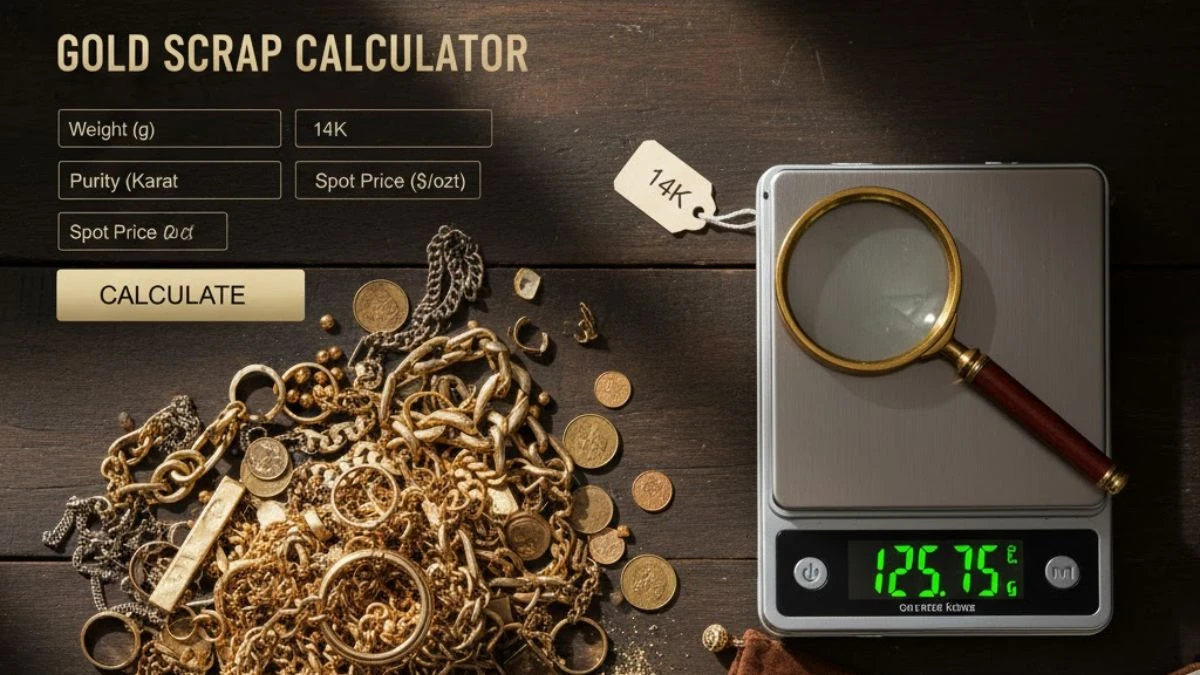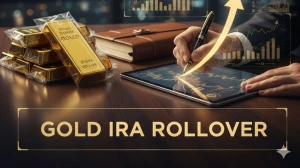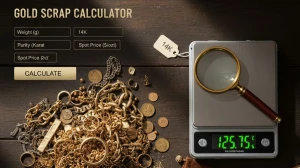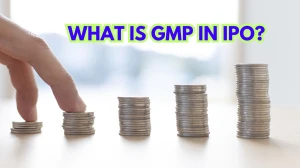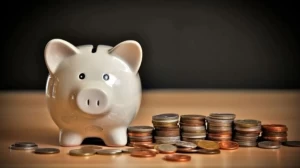
Gold Scrap Value Calculator 2025: How Much Is Your Broken Jewelry Worth?
Calculate your broken gold jewelry's scrap value instantly. Learn what pawn shops, refineries, and gold buyers pay (40-95% of spot). Complete 2025 guide with karat formulas.
by Admin
Published Oct 23, 2025 | Updated Oct 23, 2025 | 📖 18 min read
On This Page
- What Is Gold Scrap and Why Does It Have Value?
- The Gold Scrap Value Formula: How to Calculate What You Should Get
- Gold Scrap Calculator: Quick Reference Tables
- Where to Sell Gold Scrap: Detailed Comparison
- How to Identify Your Gold's Karat: Reading Hallmarks
- Common Gold Scrap Scams (And How to Avoid Them)
- Maximizing Your Gold Scrap Payout: Insider Tips
- Special Cases: Dental Gold, Gold Coins, and Mixed Metal Scrap
- Tax Implications of Selling Gold Scrap
- Frequently Asked Questions
- Conclusion: Get Maximum Value for Your Broken Gold
Do you have broken gold jewelry, old chains, mismatched earrings, or dental gold sitting in a drawer? With gold prices at historic highs of $4,000+ per ounce in 2025, that "junk drawer" gold could be worth hundreds or even thousands of dollars—but only if you know how to calculate its true scrap value and avoid getting ripped off.
The gold scrap industry is notoriously confusing, with buyers offering wildly different prices for the same items. Pawn shops might offer you 40% of your gold's value, while online refineries could pay 90%+ for the exact same broken necklace. The difference between a bad deal and a great deal could mean hundreds of dollars in your pocket.
This comprehensive 2025 guide reveals exactly how to calculate your broken gold jewelry's scrap value, what different buyers actually pay, and the insider strategies to get the maximum cash for your unwanted gold. Whether you have a single broken ring or pounds of scrap gold, you'll learn the precise formulas, avoid common scams, and discover where to sell for top dollar.
What Is Gold Scrap and Why Does It Have Value?
Gold scrap refers to any gold item that has little or no value as jewelry due to damage, age, or lack of aesthetic appeal, but retains value for its gold content. This includes:
- Broken jewelry: Snapped chains, bent rings, single earrings
- Outdated styles: Old-fashioned pieces you'll never wear
- Dental gold: Gold crowns, bridges, fillings
- Damaged items: Scratched, dented, or tarnished pieces
- Mismatched items: Single cufflinks, lone earrings
- Scrap findings: Broken clasps, damaged settings
Unlike collectible or antique jewelry valued for craftsmanship or history, scrap gold is valued purely for its melt value—the amount of pure gold it contains multiplied by the current gold spot price.
Why Gold Scrap Is More Valuable Than Ever in 2025
With gold reaching unprecedented prices of $4,093 per troy ounce as of October 2025 (up 60% year-over-year), the scrap value of your broken jewelry has never been higher. A broken 14K gold necklace that might have been worth $200 in scrap value in 2020 could now be worth $350-400 in 2025.
This price surge has created a booming market for gold scrap, with refineries, pawn shops, jewelers, and online buyers competing aggressively for your unwanted gold.
The Gold Scrap Value Formula: How to Calculate What You Should Get
Calculating your gold scrap's true value involves a simple formula, but understanding each component is crucial to avoiding lowball offers.
The Basic Formula
Scrap Value = Weight (grams) × Purity (percentage) × Spot Price per Gram × Buyer's Payout Rate
Let's break down each component:
1. Weight (in grams or troy ounces)
You'll need a digital jewelry scale accurate to at least 0.1 grams. Kitchen scales aren't precise enough for gold.
- 1 troy ounce = 31.1035 grams (standard for gold pricing)
- 1 regular ounce = 28.35 grams (don't confuse with troy ounce!)
- 1 pennyweight (dwt) = 1.555 grams
Example: Your broken chain weighs 15.3 grams
2. Purity (karat percentage)
Gold purity is measured in karats (K), with 24K being 100% pure gold. Most jewelry uses lower karats mixed with other metals for durability:
| Karat | Gold Purity | Percentage | Common Use |
|---|---|---|---|
| 24K | 999/1000 (99.9%) | 100% | Investment bars, coins |
| 22K | 916/1000 (91.6%) | 91.67% | High-end jewelry (India, Middle East) |
| 18K | 750/1000 (75%) | 75% | Fine jewelry (Europe) |
| 14K | 585/1000 (58.5%) | 58.33% | Most common (USA) |
| 10K | 417/1000 (41.7%) | 41.67% | Budget jewelry (USA minimum) |
| 9K | 375/1000 (37.5%) | 37.5% | Entry-level jewelry (UK, Australia) |
Example: Your chain is marked "14K" = 58.33% pure gold
3. Current Gold Spot Price per Gram
The gold spot price changes constantly throughout the trading day. As of October 23, 2025:
- Gold spot price: $4,093.05 per troy ounce
- Per gram: $4,093.05 ÷ 31.1035 = $131.56 per gram
Always check current prices at sites like Kitco.com, GoldPrice.org, or your local gold buyer's website.
4. Buyer's Payout Rate (The Critical Factor)
This is where most people get confused—and where you can lose hundreds of dollars if you don't know what's fair.
No gold buyer pays 100% of spot price. They need to cover refining costs, overhead, and profit margin. The question is: what percentage is reasonable?
| Buyer Type | Typical Payout | Speed | Best For |
|---|---|---|---|
| Pawn Shops | 40-70% of spot | Same day (cash) | Emergency cash needs |
| "Cash for Gold" Stores | 50-75% of spot | Same day | Convenience (risky) |
| Local Jewelers | 70-85% of spot | 1-2 days | Established relationships |
| Online Gold Buyers | 70-90% of spot | 3-7 days | Competitive offers |
| Gold Refineries (Direct) | 90-98% of spot | 7-14 days | Large quantities (100g+) |
| Private Buyers (Craigslist) | Variable (risky) | Same day | Experienced sellers only |
Complete Calculation Example
Let's calculate the scrap value of a broken 14K gold chain:
Given:
- Weight: 15.3 grams
- Karat: 14K (58.33% pure gold)
- Current spot price: $131.56 per gram
- Buyer payout rate: 80% (online buyer)
Step 1: Calculate pure gold content
15.3 grams × 0.5833 (58.33%) = 8.92 grams of pure gold
Step 2: Calculate melt value at spot price
8.92 grams × $131.56/gram = $1,173.51 (100% spot value)
Step 3: Apply buyer's payout rate
$1,173.51 × 0.80 (80%) = $938.81 (what you should receive)
Reality check: If a pawn shop offers you only $500 for this chain (42.6% of spot), you'd be losing $438.81 compared to a fair 80% payout!
Gold Scrap Calculator: Quick Reference Tables
Use these tables to quickly estimate your scrap gold value at current 2025 prices ($131.56/gram spot price).
10K Gold Scrap Value Per Gram
| Weight | 100% Spot Value | 80% Payout | 70% Payout | 60% Payout |
|---|---|---|---|---|
| 1 gram | $54.82 | $43.86 | $38.37 | $32.89 |
| 5 grams | $274.10 | $219.28 | $191.87 | $164.46 |
| 10 grams | $548.21 | $438.57 | $383.75 | $328.93 |
| 20 grams | $1,096.42 | $877.14 | $767.49 | $657.85 |
14K Gold Scrap Value Per Gram
| Weight | 100% Spot Value | 80% Payout | 70% Payout | 60% Payout |
|---|---|---|---|---|
| 1 gram | $76.74 | $61.39 | $53.72 | $46.04 |
| 5 grams | $383.71 | $306.97 | $268.60 | $230.23 |
| 10 grams | $767.43 | $613.94 | $537.20 | $460.46 |
| 20 grams | $1,534.86 | $1,227.89 | $1,074.40 | $920.92 |
18K Gold Scrap Value Per Gram
| Weight | 100% Spot Value | 80% Payout | 70% Payout | 60% Payout |
|---|---|---|---|---|
| 1 gram | $98.67 | $78.94 | $69.07 | $59.20 |
| 5 grams | $493.35 | $394.68 | $345.35 | $296.01 |
| 10 grams | $986.70 | $789.36 | $690.69 | $592.02 |
| 20 grams | $1,973.40 | $1,578.72 | $1,381.38 | $1,184.04 |
22K Gold Scrap Value Per Gram
| Weight | 100% Spot Value | 80% Payout | 70% Payout | 60% Payout |
|---|---|---|---|---|
| 1 gram | $120.54 | $96.43 | $84.38 | $72.32 |
| 5 grams | $602.71 | $482.17 | $421.90 | $361.63 |
| 10 grams | $1,205.43 | $964.34 | $843.80 | $723.26 |
| 20 grams | $2,410.86 | $1,928.69 | $1,687.60 | $1,446.52 |
Note: All values calculated at $4,093.05/oz ($131.56/gram) spot price as of October 23, 2025. Always verify current spot prices before selling.
Where to Sell Gold Scrap: Detailed Comparison
Knowing the value is only half the battle—choosing the right buyer determines whether you get a fair price or get ripped off.
1. Pawn Shops
Typical Payout: 40-70% of spot price
Speed: Cash in hand same day
Pros: Immediate payment, no shipping, face-to-face negotiation
Cons: Usually lowest payouts, high-pressure tactics, test multiple shops
Best for: Emergency cash needs or very small amounts (under 5 grams)
Insider tip: Never accept the first offer. Visit 3-5 pawn shops and use competing quotes to negotiate higher. Some shops will match or beat competitors' offers.
2. "Cash for Gold" Stores
Typical Payout: 50-75% of spot price
Speed: Same day payment
Pros: Convenient locations, no appointment needed
Cons: Aggressive sales tactics, often underpay significantly, trust issues
Best for: Quick sales if other options aren't available
Warning: Many "We Buy Gold" stores use deceptive practices like testing with wrong acids, misreporting weights, or switching items. Always watch the entire process and don't let them take your gold to a "back room."
3. Local Independent Jewelers
Typical Payout: 70-85% of spot price
Speed: 1-2 business days
Pros: Established reputation, fair dealing, may buy for store inventory
Cons: Varies by jeweler, may only buy certain karats, smaller markets
Best for: Medium quantities (10-50 grams), especially if you have an existing relationship
Insider tip: Independent jewelers with in-house designers sometimes pay above scrap value for interesting broken pieces they can repurpose. Ask if they'd pay more for design value.
4. Online Gold Buyers
Typical Payout: 70-90% of spot price
Speed: 3-7 business days (mail time + processing)
Pros: Competitive rates, convenient, insured shipping, no pressure
Cons: Shipping time, trust required, cannot see testing process
Top-rated online buyers (October 2025):
- Cash for Gold USA - Pays up to 90%, A+ BBB rating, free insured shipping
- Express Gold Cash - Pays 85-90%, same-day price guarantee
- Liberty Coin - Pays 75-85%, excellent customer service, 10-day price lock
Best for: Amounts over 10 grams when you want competitive pricing without visiting multiple shops
How it works: Request free shipping kit → Pack gold → Ship with insurance → Receive offer → Accept or request return
5. Gold Refineries (Direct)
Typical Payout: 90-98% of spot price
Speed: 7-14 business days
Pros: Highest payouts, professional assaying, handles large quantities
Cons: Minimum quantities (often 100+ grams), slower process, requires trust
Reputable refineries:
- Midwest Refineries - 95% payout, 100g minimum, full assay report
- Garfield Refining - 92-95% payout, excellent for dental gold
- Precious Metals Refining - 90-94% payout, handles mixed scrap
Best for: Large quantities (100g+), estate settlements, jewelers' scrap
6. Private Buyers (Craigslist, Facebook Marketplace)
Typical Payout: Highly variable (risky)
Speed: Variable
Pros: Potential for higher prices, no middleman
Cons: Safety risks, scam potential, counterfeit testing needed
Best for: Experienced sellers only with proper safety precautions
Safety warnings: Meet in public (police station parking lots), bring someone with you, verify gold testing on-site, accept only cash or verified bank transfer.
How to Identify Your Gold's Karat: Reading Hallmarks
Before selling, you must accurately identify your gold's karat. Most jewelry has hallmarks (stamps) indicating purity.
Common Gold Hallmarks
| Hallmark | Meaning | Purity | Where Found |
|---|---|---|---|
| 999, .999 | 24 karat | 99.9% pure | Investment bars, coins |
| 916, .916 | 22 karat | 91.6% pure | Indian, Middle Eastern jewelry |
| 750, .750, 18K | 18 karat | 75% pure | European fine jewelry |
| 585, .585, 14K | 14 karat | 58.5% pure | American jewelry (most common) |
| 417, .417, 10K | 10 karat | 41.7% pure | Budget American jewelry |
| 375, .375, 9K | 9 karat | 37.5% pure | UK, Australian jewelry |
| GP, GF, HGE | Gold Plated/Filled | Minimal value | Costume jewelry (NOT scrap gold) |
Important: Gold-plated (GP), gold-filled (GF), or heavy gold electroplate (HGE) items have almost no scrap value—they're base metal with a thin gold coating.
Where to Find Hallmarks
- Rings: Inside the band
- Bracelets/Necklaces: Near the clasp
- Earrings: On the post or back
- Watches: Inside the case back
- Pins/Brooches: On the back near the clasp
What if there's no hallmark? Items without marks might be gold (especially antique or non-Western jewelry) but require acid testing or XRF analysis. Reputable buyers will test unmarked items for free.
Common Gold Scrap Scams (And How to Avoid Them)
The gold-buying industry has its share of unethical operators. Protect yourself with these warnings:
Scam #1: The "Bait and Switch" Offer
How it works: Buyer quotes a high price initially, then "discovers" your gold is lower purity or lighter than expected, drastically lowering the offer after you've committed.
Protection: Get the quote in writing. Bring your own scale and watch them weigh items. If they change the offer significantly, walk away—you're under no obligation to sell.
Scam #2: The Disappearing Act
How it works: Buyer takes your gold to a "back room" to test or weigh it, then either switches items for lower-karat pieces or claims they're not gold.
Protection: NEVER let your gold leave your sight. All testing and weighing should happen in front of you. If they insist on privacy, leave immediately.
Scam #3: The Wrong Test Scam
How it works: Buyer deliberately uses the wrong acid test (testing 14K gold with 10K acid) to make it appear lower quality.
Protection: Learn basic acid testing yourself or ask to see all test results. Legitimate buyers welcome transparency.
Scam #4: The Rigged Scale
How it works: Buyer uses scales calibrated incorrectly or positioned to show lower weight.
Protection: Bring your own certified scale. Compare measurements. If there's a significant discrepancy (more than 0.1g), the buyer may be cheating.
Scam #5: The High-Pressure Tactic
How it works: "This offer expires in 5 minutes!" or "Gold prices are falling, sell now!" to pressure you into accepting a lowball offer.
Protection: Gold prices are public information (check Kitco.com on your phone). Never accept pressure. A reputable buyer will honor reasonable quotes for 24-48 hours.
Scam #6: Online "Free Kit" Trap
How it works: Disreputable online buyers send free shipping kits, receive your gold, then claim it's worth far less than expected. If you reject their offer, they charge "appraisal fees" or return shipping fees.
Protection: Only use online buyers with:
- A+ BBB rating with minimal complaints
- Clear "free return shipping" policy if you reject their offer
- Price lock guarantee (7-10 days)
- Transparent pricing calculator on their website
Maximizing Your Gold Scrap Payout: Insider Tips
These professional strategies can increase your payout by 20-40%:
Tip #1: Sort by Karat Before Selling
Don't mix 10K, 14K, and 18K gold together. Unethical buyers will test the lowest karat in the batch and pay you that rate for everything. Sort and sell each karat separately, or at minimum, demand separate testing for each karat.
Tip #2: Remove Non-Gold Components
Remove diamonds, gemstones, and non-gold parts (steel watch backs, clasps) before selling. Many buyers pay zero for these, but you can sell valuable stones separately or save sentimental stones.
Exception: Very small gemstone chips (under 0.10 carat) aren't worth removing—the labor exceeds their value.
Tip #3: Clean Your Gold (But Don't Over-Clean)
Lightly clean gold with warm water and mild soap to remove visible dirt. However, DON'T use harsh chemicals or abrasives—these can remove gold and reduce weight. Buyers pay by weight, not appearance.
Tip #4: Sell in Bulk When Possible
Buyers prefer larger quantities because fixed costs (testing, paperwork) are spread over more gold. If you have multiple small items, accumulate them rather than selling one earring at a time. Sellers with 50+ grams often negotiate payouts 5-10% higher.
Tip #5: Time Your Sale (Sometimes)
While "timing the market" is difficult, avoid selling during major gold price drops. If gold suddenly falls $50/oz in a day, wait a week for potential recovery. However, don't wait indefinitely hoping for perfect timing—the difference is usually small.
Tip #6: Get Multiple Quotes
This cannot be overstated: Get at least 3-5 quotes. The difference between the highest and lowest offer on the same gold can be 30-50%. One seller with 25g of 14K gold received quotes ranging from $685 to $1,150 for identical items—a $465 difference!
Tip #7: Understand Your Leverage
You have the most leverage when:
- You're not desperate for cash (can wait for better offers)
- You have a large quantity (50g+)
- You have competing quotes to reference
- You're willing to walk away from bad offers
Tip #8: Consider the "Design Premium" Exception
While most scrap gold sells for melt value only, certain pieces might be worth more intact:
- Antique jewelry (100+ years old)
- Designer pieces (Tiffany, Cartier, David Yurman)
- Unique handcrafted items
Get these appraised by a jewelry appraiser before selling for scrap—you might double or triple your money selling as collectible jewelry instead.
Special Cases: Dental Gold, Gold Coins, and Mixed Metal Scrap
Dental Gold
Dental gold (crowns, bridges, fillings) is typically 10K-16K but can be complex alloys. Some dental gold contains platinum, palladium, or silver, making it more valuable than standard jewelry gold.
Best buyers: Specialized dental gold refineries like Garfield Refining pay 92-95% because they can recover other valuable metals. General scrap buyers often pay only for gold content (60-70%), ignoring other metals.
Payout timeline: 10-14 days for full assay of all metals
Gold Coins
Gold coins fall into two categories:
Bullion coins (American Eagles, Canadian Maples, Krugerrands): These are worth MORE than scrap value—typically spot price plus 3-8% premium. NEVER sell these to scrap buyers. Sell to coin dealers or bullion dealers.
Damaged/jewelry gold coins: Coins with holes drilled (for necklaces), heavy wear, or damage might only fetch scrap value. Even then, check with a coin dealer first—some damaged coins retain numismatic (collector) value.
Mixed Metal Scrap
Jewelry combining gold with silver, platinum, or other metals requires more complex evaluation:
- Two-tone jewelry: Buyer must separate white gold from yellow gold and test separately
- Gold-silver combinations: Fire assay can separate metals, but lower payouts (80-85%) account for processing
- Gold-platinum: Both valuable; specialized refineries pay for both metals
Recommendation: For complex mixed-metal items over $500 value, use specialized refineries that perform full assays, not walk-in gold buyers.
Tax Implications of Selling Gold Scrap
Many sellers overlook tax consequences when selling gold. Here's what you need to know:
Capital Gains Tax
The IRS classifies gold as a "collectible," subject to a maximum 28% capital gains tax rate (higher than the 15-20% rate for stocks).
How it's calculated:
- Sale price - Original purchase price = Capital gain
- If you held the gold for over 1 year: 28% tax on gain (long-term)
- If held for under 1 year: Taxed as ordinary income (short-term)
Example: You sell inherited jewelry for $2,000 (purchased for $500 twenty years ago):
Capital gain: $2,000 - $500 = $1,500
Tax owed: $1,500 × 0.28 = $420
Stepped-Up Basis for Inherited Gold
If you inherited gold, your "cost basis" is the value on the date of the original owner's death, not what they paid. This can dramatically reduce capital gains.
Example: Your grandmother bought a necklace for $200 in 1980. When she died in 2024, it was worth $1,500. You sell it in 2025 for $1,600.
Your capital gain: $1,600 - $1,500 = $100 (not $1,400!)
Tax owed: $100 × 0.28 = $28
Reporting Requirements
Gold dealers must file Form 1099-B with the IRS for certain transactions:
- Sale of 25 or more troy ounces of gold bars
- Sale of gold coins meeting specific criteria
Scrap jewelry sales typically don't trigger automatic reporting, but you're still legally required to report capital gains on your tax return (Schedule D).
Cash Transaction Limits
If you receive more than $10,000 cash in a single transaction (or related transactions), the buyer must file Form 8300 with the IRS. This applies whether you sell to one buyer or multiple buyers in related transactions.
Recommendation: Consult a tax professional for sales over $5,000 or if you're selling inherited gold. Proper documentation can save hundreds in taxes.
Frequently Asked Questions
How much is scrap gold worth per gram in 2025?
As of October 23, 2025, with gold at $4,093/oz, scrap gold values per gram are: 10K = $54.82 (100% spot) or $38-44 (typical payout), 14K = $76.74 (100% spot) or $54-61 (typical payout), 18K = $98.67 (100% spot) or $69-79 (typical payout). Actual payouts range from 60-90% of spot value depending on buyer.
Where can I sell scrap gold for the best price?
Direct gold refineries offer the highest payouts (90-98% of spot price) but require larger quantities (100g+). For smaller amounts, reputable online gold buyers pay 80-90%, local jewelers pay 70-85%, and pawn shops typically pay only 40-70%. Always get 3-5 quotes to compare.
How do I know if my jewelry is real gold or gold-plated?
Check for hallmarks: real gold shows stamps like 10K, 14K, 18K, 585, 750, or 916. Gold-plated items are marked GP, GF, or HGE and have minimal scrap value. If unmarked, use a magnet test (real gold isn't magnetic) or acid test, or have it professionally tested for free at gold buyers.
Do pawn shops pay fair prices for scrap gold?
Pawn shops typically pay 40-70% of spot price, which is below fair market rates. They offer convenience and immediate cash but rarely provide the best value. For better payouts, visit multiple shops to compare offers, or use online gold buyers (80-90% payouts) or refineries (90-95% for larger quantities).
What percentage of gold value should I expect when selling scrap?
Expect 70-85% of spot price from reputable buyers. Pawn shops pay 40-70%, online buyers pay 70-90%, local jewelers pay 70-85%, and refineries pay 90-98% (for 100g+ quantities). Anything below 60% is a lowball offer unless the gold has authenticity questions.
Is it better to sell gold now or wait for higher prices?
With gold at historic highs ($4,093/oz in October 2025), current prices are excellent. While experts forecast $4,500-5,000 in 2026, trying to time the perfect peak is difficult. If you need cash or have no use for the gold, selling at current prices is reasonable. For long-term holdings, consider keeping investment-grade gold.
How can I avoid getting scammed when selling gold?
Never let your gold leave your sight, get multiple quotes (3-5 minimum), bring your own scale to verify weight, understand your gold's karat and approximate value beforehand, resist high-pressure tactics, and only use buyers with strong reputations (A+ BBB rating for online buyers). If an offer seems too low, walk away.
Should I remove gemstones before selling gold for scrap?
Yes, remove valuable gemstones (diamonds 0.25ct+, sapphires, rubies) before selling gold for scrap, as most scrap buyers pay nothing for stones. Sell valuable gems separately to jewelers or gemstone dealers. However, tiny chips under 0.10ct aren't worth the effort to remove—the labor exceeds their value.
Conclusion: Get Maximum Value for Your Broken Gold
Selling scrap gold doesn't have to be complicated or stressful if you understand the process and know what to expect. With gold at historic highs in 2025, your broken jewelry, old chains, and unwanted gold items are worth more than ever—potentially hundreds or thousands of dollars.
The key takeaways:
- Know your gold's value: Use the formula (Weight × Purity × Spot Price × Payout Rate) to calculate fair value before selling
- Understand realistic payouts: Expect 70-85% from reputable buyers; anything below 60% is likely a scam
- Shop around: Get 3-5 quotes minimum—the difference can be hundreds of dollars
- Avoid common scams: Never let gold leave your sight, bring your own scale, resist pressure tactics
- Choose the right buyer: Pawn shops for emergency cash, online buyers for convenience, refineries for large quantities
- Consider timing and taxes: Sell during stable or rising gold prices; understand capital gains tax implications
Remember: You're in control. A reputable buyer will welcome transparency, answer your questions, show you the testing process, and give you time to consider their offer. If you feel pressured or uncomfortable, walk away—your gold will still be valuable tomorrow.
With gold scrap prices near all-time highs, there's never been a better time to turn that drawer full of broken jewelry into cash. Use this guide to ensure you get the maximum value for every gram.
Always verify current gold spot prices before selling at reliable sources like Kitco.com, GoldPrice.org, or your gold buyer's transparent pricing page. The prices and percentages in this guide are based on October 2025 market conditions and may change.
Disclaimer: This article is for educational purposes only and does not constitute financial or tax advice. Consult with a financial advisor or tax professional for personalized guidance on selling gold and tax implications.
Last updated: October 23, 2025
Gold spot price at publication: $4,093.05 per troy ounce ($131.56 per gram)
FAQs - Gold Scrap Value Calculator 2025
. How much is scrap gold worth per gram in 2025?
As of October 23, 2025, with gold at $4,093/oz, scrap gold values per gram are: 10K = $54.82 (100% spot) or $38-44 (typical payout), 14K = $76.74 (100% spot) or $54-61 (typical payout), 18K = $98.67 (100% spot) or $69-79 (typical payout). Actual payouts range from 60-90% of spot value depending on buyer.
. Where can I sell scrap gold for the best price?
Direct gold refineries offer the highest payouts (90-98% of spot price) but require larger quantities (100g+). For smaller amounts, reputable online gold buyers pay 80-90%, local jewelers pay 70-85%, and pawn shops typically pay only 40-70%. Always get 3-5 quotes to compare.
. How do I know if my jewelry is real gold or gold-plated?
Check for hallmarks: real gold shows stamps like 10K, 14K, 18K, 585, 750, or 916. Gold-plated items are marked GP, GF, or HGE and have minimal scrap value. If unmarked, use a magnet test (real gold isn't magnetic) or acid test, or have it professionally tested for free at gold buyers.
. Do pawn shops pay fair prices for scrap gold?
Pawn shops typically pay 40-70% of spot price, which is below fair market rates. They offer convenience and immediate cash but rarely provide the best value. For better payouts, visit multiple shops to compare offers, or use online gold buyers (80-90% payouts) or refineries (90-95% for larger quantities).
. What percentage of gold value should I expect when selling scrap?
Expect 70-85% of spot price from reputable buyers. Pawn shops pay 40-70%, online buyers pay 70-90%, local jewelers pay 70-85%, and refineries pay 90-98% (for 100g+ quantities). Anything below 60% is a lowball offer unless the gold has authenticity questions.
. Is it better to sell gold now or wait for higher prices?
With gold at historic highs ($4,093/oz in October 2025), current prices are excellent. While experts forecast $4,500-5,000 in 2026, trying to time the perfect peak is difficult. If you need cash or have no use for the gold, selling at current prices is reasonable. For long-term holdings, consider keeping investment-grade gold.
. How can I avoid getting scammed when selling gold?
Never let your gold leave your sight, get multiple quotes (3-5 minimum), bring your own scale to verify weight, understand your gold's karat and approximate value beforehand, resist high-pressure tactics, and only use buyers with strong reputations (A+ BBB rating for online buyers). If an offer seems too low, walk away.
. Should I remove gemstones before selling gold for scrap?
Yes, remove valuable gemstones (diamonds 0.25ct+, sapphires, rubies) before selling gold for scrap, as most scrap buyers pay nothing for stones. Sell valuable gems separately to jewelers or gemstone dealers. However, tiny chips under 0.10ct aren't worth the effort to remove—the labor exceeds their value.
